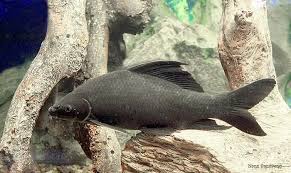
Labeo Fish
Conditions of detention
Labeo fish are active swimmers and require a well-maintained tank with plenty of space. A minimum tank size of 55 gallons is recommended for a single Red-Tail Shark, with larger tanks needed for the Black Sharkminnow, which can grow much larger. These fish prefer water temperatures between 72-79°F (22-26°C) and slightly acidic to neutral water with a pH range of 6.5 to 7.5. Labeo fish are territorial, so it’s important to provide plenty of hiding spots, such as caves, rocks, and dense plants, to help reduce aggression and establish territories.
Useful Fact: Labeo fish are best kept alone or with other robust species in a large tank, as they can become territorial and aggressive, particularly towards fish of similar size or shape.
Nutrition and diet
Labeo fish are omnivorous and thrive on a varied diet. They should be fed high-quality sinking pellets or wafers, supplemented with live or frozen foods such as bloodworms, brine shrimp, and daphnia. They also enjoy fresh vegetables like blanched spinach, zucchini, and peas, which can be added to their diet for extra nutrition.
Useful Fact: Labeo fish enjoy grazing on algae, so providing a well-balanced diet that includes vegetable matter can help maintain their health and reduce their aggressive tendencies.
Health
Labeo fish are generally hardy, but they can be susceptible to common freshwater diseases such as ich, fin rot, and bacterial infections, particularly if water quality is poor or if they are stressed by aggressive tankmates. Regular monitoring of water parameters and maintaining a clean environment are essential for preventing disease.
Useful Fact: Regular water changes and stable water conditions are key to keeping Labeo fish healthy, as they can be sensitive to sudden changes in their environment.
Grooming and care
Labeo fish do not require traditional grooming, but their environment needs regular maintenance. Given their active nature, frequent water changes (about 20-30% weekly) and strong filtration are necessary to maintain water quality. It’s also important to monitor their interactions with tankmates, as Labeo fish can become increasingly territorial as they mature.
Useful Fact: Providing a well-structured environment with plenty of hiding spots can help reduce stress and aggression in Labeo fish, particularly as they establish territories.
Education and training
Labeo fish are not typically trained, but they can learn to recognize their owners and will often come to the front of the tank during feeding times. While not as interactive as some other species, their active swimming and territorial behavior make them engaging to observe.
Useful Fact: Labeo fish are more likely to display their natural behaviors when they feel secure in a well-maintained and appropriately sized tank.
Toys and entertainment
Labeo fish enjoy exploring their environment, so providing them with a well-decorated tank that includes caves, rocks, and dense plants gives them plenty of places to explore and establish territories. They are also known for their territorial behavior, often patrolling their chosen area of the tank.
Useful Fact: Labeo fish are active swimmers that enjoy having plenty of open space to swim, so balancing hiding spots with open areas is important for their well-being.
Safety
Labeo fish can be territorial and aggressive, particularly toward fish of similar size or shape. It’s important to choose tankmates carefully, avoiding other bottom-dwellers or species that may provoke aggression. They should be housed in a secure tank with a tight-fitting lid, as they are known to jump when startled.
Useful Fact: To reduce aggression, Labeo fish should be the only one of their species in a tank or kept in very large tanks with plenty of space to establish territories.
Accessories
Essential accessories for a Labeo tank include a powerful filter to maintain water quality, a heater to keep the temperature stable, and a secure lid to prevent jumping. Labeo fish appreciate a tank with plenty of hiding spots created by caves, rocks, and plants. A sandy or fine gravel substrate is ideal for their foraging behavior.
Useful Fact: Labeo fish prefer a tank setup that mimics their natural environment, with plenty of rocky caves and dense vegetation to establish territories.
Socialization
Labeo fish are territorial and can be aggressive, particularly towards other fish of similar size or shape. They are best kept alone or with other robust species that can tolerate their aggressive tendencies. It’s important to monitor their interactions closely, especially if kept in a community tank, to prevent bullying or stress.
Useful Fact: When keeping Labeo fish in a community tank, choose tankmates that are fast swimmers and occupy different areas of the tank to minimize territorial disputes.
Travel and Transportation
When transporting Labeo fish, use a plastic bag filled with water from their tank and ensure it is well-oxygenated. Transport them carefully to avoid temperature fluctuations and stress. Keep the bag in a dark, insulated container to minimize stress.
Useful Fact: Labeo fish are relatively hardy during transport but should be acclimated slowly to their new environment to reduce stress and prevent shock.
Behavior and psychology
Labeo fish are known for their territorial and sometimes aggressive behavior. They are active swimmers that enjoy patrolling their territory and will often chase away other fish that encroach on their space. As they mature, their territorial behavior can become more pronounced, so it’s important to provide a tank setup that allows them to establish and defend their territory without causing harm to other tankmates.
Useful Fact: Labeo fish are most comfortable when they have established a clear territory within the tank, so providing plenty of hiding spots and open areas for swimming is essential.
Legal aspects
There are generally no legal restrictions on owning Labeo fish, but it’s important to ensure they are sourced from reputable breeders or suppliers. As with all fish, ethical sourcing helps support sustainable practices and ensures the health of the fish.
Useful Fact: Many Labeo fish available in the aquarium trade are captive-bred, which helps reduce pressure on wild populations and ensures healthier fish for the aquarium.


